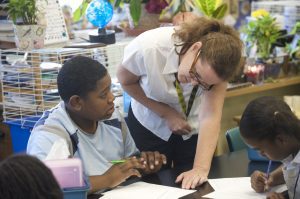 In order to rebuild the Baltimore economy, we need to repopulate the city. To do that, we need to give people and businesses a safer environment, obviously, but also a superior public school system that young families with children can respect, that’s competitive with what the suburbs have to offer. That’s why Baltimore Rising is interested in effecting a dramatic, relatively short-term improvement in the quality of public education everywhere in the city. Everywhere. This isn’t about opening a special charter school here and there.
In order to rebuild the Baltimore economy, we need to repopulate the city. To do that, we need to give people and businesses a safer environment, obviously, but also a superior public school system that young families with children can respect, that’s competitive with what the suburbs have to offer. That’s why Baltimore Rising is interested in effecting a dramatic, relatively short-term improvement in the quality of public education everywhere in the city. Everywhere. This isn’t about opening a special charter school here and there.
Some friends of ours are a young professional couple who have recently purchased a newly refurbished home in the city. The neighborhood isn’t spectacular, but it’s decent enough. “In transition” is the operative phrase. They’re good, smart people who are living here because they like city life and its convenient to where they work. And, make no mistake about it, they like Baltimore, “But we’ll be moving out in a few years,” she told us. “When we have kids,” her husband finished the thought for her. “We can’t raise our children here.”
It’s not just about the schools, of course. Crime is a problem, although where they’re living now is a pretty safe neighborhood. And the look of the city is unfortunate, whichever way you drive, with all the vacant, boarded up places. Honestly, it’s not just unattractive. It’s depressing. Doesn’t exactly make the impression the city needs to regrow its population and attract fresh business and employers. It’s certainly not what the people already living in these neighborhoods deserve.
Okay, so what can we do about it? How do we improve our public schools and do it quickly, particularly in light of the city’s fiscal crisis, the one people don’t talk about as much as they should?
Round numbers, the city spends only $300 million a year for public education out of a total budget in excess of $2.5 billion. The federal government chips in another $28 million. The state, another $14 million. So, $342 million total. It’s not nearly enough of course but, for now, it’s all we have to spend. The fact that the city spends more than twice as much, $750 million a year, on public safety isn’t helping anything, but it’ll be a while before we can do anything about that.
- We start by taking back the Board of Education. It’s been 20 years, during the Schmoke administration, since the state took over without any appreciable, beneficial impact on the quality of the city’s schools. Fine. The state has had its chance. It’s time the city took back control over the destiny of its children.
- We focus pretty much every dollar the city can spare on effecting immediate
 and dramatic improvements to pre-school through third grade. Bring these early years up to standard and then some. Give these kids an education – teachers, programs, facilities – that r
and dramatic improvements to pre-school through third grade. Bring these early years up to standard and then some. Give these kids an education – teachers, programs, facilities – that r
ival the best they could get anywhere in the state. Don’t worry so much about the buildings. A lot of us went to old schools without air conditioning and we’ve done well. Quality teachers educate our kids, not bricks and mortar.
- We continue to improve the system – everywhere in the city, not just in the best neighborhoods – one grade at a time as our third graders grow up. Now you know why this is a 9 year plan.
- In the meantime, we give fourth graders on up whatever remedial education they need so that students who can do better don’t fall behind.
Nine years later, we will have given our entire public school system a complete, badly needed makeover. And during that same 9 years, with luck and hard work, maybe we can bring more than a few new employers and other businesses into the city and begin to repopulate our neighborhoods – growing the city’s property tax and income tax base in the process.

